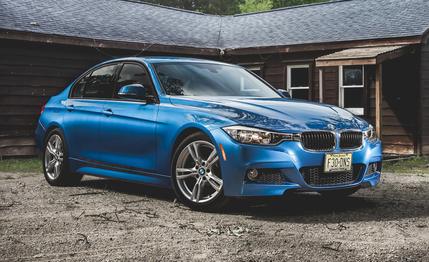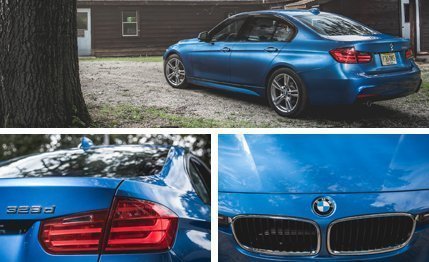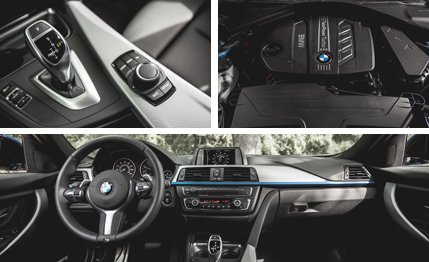 Instrumented Test
Instrumented Test
Of course you’re wondering, so we’ll just tell you up front: 39 mpg. That’s what we got over 522 miles of driving with the BMW 328d rear-drive sedan, which amounts to one fill-up. It’s also 4-mpg better than the 35 mpg we saw from two 2014 328ds, an xDrive sedan and our long-term xDrive wagon (through 25,000 miles, at least).
That’s all the choices: rear- or all-wheel drive, sedan or wagon. The only 3-series diesel available in the U.S. comes with an eight-speed automatic, whether you like it or not, but confers a real mileage benefit compared with our long-term 2012 328i manual (27 mpg over 40,000 miles). Neo-Prius fuel economy in the industry’s benchmark sports sedan? Sign here, please.
Our U.K. correspondent, Mike Duff, doesn’t think much of BMW diesels, especially the small ones. Recently he was overheard calling them “crap,” which is British shorthand for “not quite as lovely as the alternatives.” Duff wonders why some Americans get all frothy about a 3-series diesel when they’re common as cats in Europe, where they’re the preferred mount of widows, vicars, airport taxi drivers, and other people who want BMW prestige and luxury on the slowest, most frugal possible terms. In Duff’s estimation, a 328d is as close as BMW comes to building a Buick Verano.

Well, you’re all quite acquainted with the F30-generation 3-series, thanks to the umpteen million stories we’ve done on this vehicle, calling out its sophisticated handling, its sugary engines, its fine brakes, and its diminished steering, which is definitely colder than the previous E90’s. None of those observations change for the 328d, except the diesel engine and its numbers.
To wit: In the United States, you pay a $1500 premium to swap out the 2015-model 328i’s base 2.0-liter turbo gasoline four for the 328d’s 2.0-liter turbo-diesel. It’s not a huge hit, considering you get better economy, a major torque bump of 25 lb-ft, and a lot of fancy new antipollution equipment. Rated horsepower drops from 240 to 181, as horsepower always takes a dive when you install a slower-turning diesel.
When will the $1500 pay itself back in fuel savings? If you accept our fuel-economy numbers as your own and take the U.S. fuel-price averages as this is written ($3.50 per gallon for premium, $3.66 for diesel), you’ll pay off the 328d’s diesel in about 42,000 miles. Of course, the break-even point can vary depending on your own mileage and the disparity between gasoline and diesel prices where you drive.
If you are the leasing type and plan to turn it in at two or three years, forget any economic benefit to a 328d. The remaining advantage is the convenience of a 500-plus-mile range, which you could regard as an extracost option like a sunroof or a fancier stereo. Not having to stop so often at fuel pumps—especially greasy diesel pumps—is worth something to some people.
While a 328d buyer gains significant economy, he or she is also sacrificing. A reason that blue spinner on the hood commands the big premium is the company’s long history of building graceful engines that swing to high revs while making only the most dulcet of tones. In the diesel, you chuck a thoroughbred and in its place install a clattering plow mule of an engine that spends most of its life lazing between 1000 and 2000 rpm, with unenthusiastic plods to 4000 rpm when you’re really on it. This engine is an industrial thing built for a prosaic purpose rather than to satisfy a passion.

Let’s not overstate it. As diesels go, the 328d’s is pleasant enough, the steel-cut rattling of its four jugs noticeable but well muffled in the cabin. The immediacy of peak torque arriving at 1750 rpm and staying through to 2750 rpm ensures that the 328d never feels slow. The 60-mph benchmark passes in 6.8 seconds, which is fast enough that you won’t get flattened while merging but at the muddy bottom of the sports-sedan pond. Our long-term 328i manual could do it in 5.6 seconds, an altogether more BMW-like time; the aforementioned diesel xDrive sedan, 161 pounds heavier, took 7.2 seconds. So, at least this rear-driver avoids the ignominy of being the slowest 3-series.
BMW pricing can catch you out if you’re not careful. Our 2014 328d totaled out at $45,075 with only a few options, including the $3500 M Sport package (wheels, suspension, seats, trim), the $1000 Dynamic Handling pack, $550 Estoril blue paint, and a $500 sport automatic transmission upgrade, which includes steering-wheel paddles and sportier shift maps. Hot M-like looks notwithstanding, this 328d had few frills; no navigation, no backup camera, no parking sensors, no satellite radio. It’s basically a Munich taxi with nice wheels and paint. Those pining after the E90 cars will remember the twin-turbo six-cylinder 2009 BMW 335d that delivered 5.7-second 0-to-60-mph performance while burning diesel at 28 mpg. It was no taxi, but five years ago its sticker was $10,000 higher than the one on this car; it didn’t sell well.
Some of you actually crave stripped-down Bimmers and Benzes with reputedly indestructible diesel engines. This is what Europeans in this segment buy, mostly, and owning one stateside brings you certain credibility as a connoisseur of The Real Thing. If you can’t live in Germany—or don’t want to because the winters suck, socialists rule, and a good hamburger isn’t available at midnight—then owning a 328d is the next best thing. However, you must remember that those people buy diesels because their gasoline is roughly $8.00 per gallon and diesel is not only more efficient, but cheaper (about $7.20 at press time). Here, if you’re looking to drink from the full fire hose of BMW fabulousness, stick with gasoline.